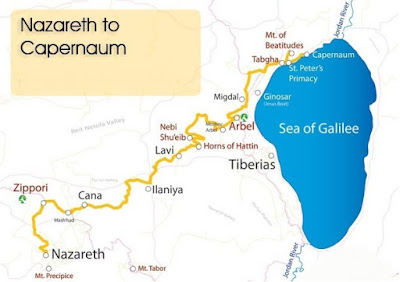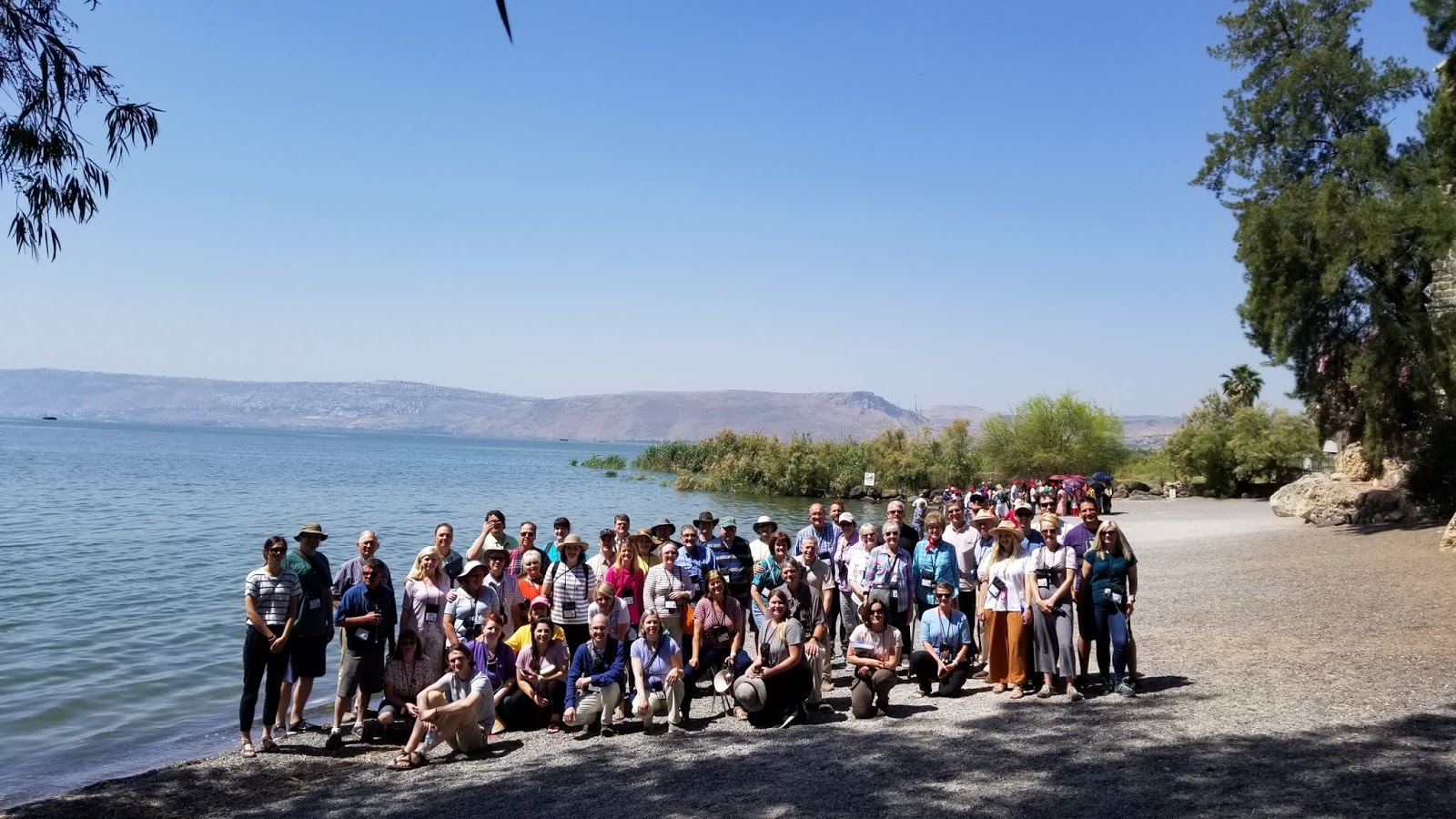Valley of the Doves
We started our first day in Galilee with a devotional and walk in
Wadi Hamam, or "The Valley of the Doves." Under the cliffs of
Mount Arbel, this valley marks the route of the branch of the old V
ia Maris,
or "Way of the Sea" that led from the coast inland towards Damascus and
eventually to Mesopotamia. Because it passed near Nazareth on its way
to the Sea of Galilee, this was doubtlessly
the route that Jesus would have taken as he walked from his home town to the Sea of Galilee, where so much of his mortal mission took place.
Under a tree near the main road, we talked about Jesus' call of his first disciples in Matthew 4 an John 1 and what it meant to follow him. We then sang "Come Follow Me" and then separated, walking up the valley alone in silence to find places to meditate, reflect, and pray.
 |
| The Ancient Via Maris, which had left the coast and then passed Megiddo, winds through Galilee (including Nazareth) until it emerges under Mount Arbel at the Sea of Galilee |
 |
| Returning to our bus at he main road after walking in silence up the valley for personal reflection and prayer |
Mount of Beatitudes
Next we continued on to
the Mount of Beatitudes,
which is always one of my favorites. We talked a
bit about the intent of the overall Sermon on the Mount, discussed how Jesus fulfilled the Law and then had nine members of our group take turns reading each of the Beatitudes in Matthew 5:1–12. After reading
Matthew 5:48 and offering a control on unintended and unhelpful
perfectionism. After reciting the Lord's Prayer together and singing “More Holiness Give Me,” I offered a prayer. We then had some time on
the lovely grounds.
St. Peter's Primacy
Our next stop was
St. Peter’s Primacy,
the traditional site of the appearance of the Risen Lord to seven
disciples on the shores of the Sea of Galilee. I read and taught from
John 21, after which we sang “My Redeemer Lives.” The site takes its
name from Jesus commission of Peter to "feed his sheep." I ended by discussing the model of the Beloved Disciple who is last seen following the Risen Lord as a model of discipleship for all of us. (you could see the conclusion of my
Becoming the Beloved Disciple for more on this 😉)
 |
| Choir pic |
 |
| Ward pic |
 |
| Ancient Scripture Geek pic (with my buddy an fellow faculty member Tyler Griffin) |
After the usual
pictures next to, and some wading in, the Sea of Galilee, we looked
into the small chapel that features the
mensa Christi, or "meal of
Christ," rock which is said to be where Jesus fed the disciples.


 |
| Because the chapel was so crowded today, I am including this picture of the mensa Christi that I took at my last trip in December (hence the Christmas decorations) |
|
Church of the Multiplication
We then walked down to
Tabgha, where we gathered for our devotional in the atrium of the
Church of the Multiplication.
Read Mark 6:41–44, mentioned parts of the Bread of Life Discourse from
John 6.
 |
| The current Church of the Multiplication is a modern sanctuary built to evoke the original early Christian basilica built to commemorate the miracle of the Feeding of the 5,000 |
 |
| The cool, peaceful courtyard of the basilica is where we held our devotional |
 |
| The floor includes parts of ancient mosaics that have been restored or completed. This is the "Nilometer" which measured the Nile River's annual flooding |
 |
| Under the altar is an early Christian mosaic of the loaves and the fishes. Although the text says there were 5 loaves, there are only 4 in this basket, because the fifth is Jesus, the Bread of Life |
Caesarea Philippi (Banias)
 |
| The waters of Banias flowing out from the cave dedicated anciently to Pan |
After Tabgha, we drove through Upper Galley, climbing the hills and
passing through the Hula Valley before coming to Banias, where we had
lunch at the Lebanese Restaurant. We then walked into the National Park
that contains
Caesarea Philippi. Here we talked about Peter’s Confession in Mark 8:27–30 and Matthew
16:13–20 and sang "We're Not Ashamed to Own Our Lord."
One of the three headwaters of
the Jordan River actually emerges from a cave just above the classical
site, which in Jesus' time was the capital of the tetrarchy of Herod's
son Philip. In the Hellenistic Period a sanctuary to the nature god Pan
had been built here, which is still recalled in the Arabic name for the
site,
Banias. Herod had also built a temple to Augustus here, and
all this paganism puts the declaration of Jesus in a different context.
Here was the true Son of God.
It later was the capital of a small kingdom given to
Agrippa II, a great grandson of Herod the Great and the son of Agrippa I.
 |
| The cave of Pan was seen anciently as the gates of the Underworld (Hades or "Hell"). |
Usually our groups drive down the rushing stream a bit to see how they plunge dramatically into a gorge at Banias Falls, but some construction was being done at this site so we missed it this trip.
Mount Bental
Out last stop for the day was on the border of the Golan Heights, where
Har Bental overlooks the Syrian border, and the city of Quneitra. At its top their is an old Israeli Defense Forces outpost that overlooks an earlier Syrian pill box.













































One place stands out for me on this day of the tour...the Valley of the Doves. I was enchanted by its peace, the actual sound of doves, and most especially because of the Savior’s place in its storied history. A good friend compared it to the temple in meaning and spirit. I agree. I was searching for that very feeling.
ReplyDelete